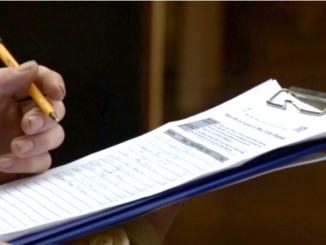
BY ALLISON LEVITSKY
Daily Post Staff Writer
A set of voluntary design guidelines for Palo Alto’s Eichler homes — the iconic post-World War II houses that make up about 17% of the city’s single-family housing stock — got the go-ahead at City Council last night (April 2).
The rules are meant to preserve privacy and architectural homogeny in the city’s Eichler tracts, which comprise about 2,700 of the city’s 15,000 to 16,000 houses.
Palo Alto has the highest concentration of Eichlers in the world, Mayor Liz Kniss pointed out.
Council voted 7-1, with Councilwoman Karen Holman dissenting and Councilman Tom DuBois absent, to approve the guidelines as voluntary.
In a motion, Councilman Greg Scharff directed city planners to develop a process whereby a supermajority of homeowners in an Eichler tract could ensure the use of guidelines for two-story homes within the district, and for a mechanism whereby a neighborhood could choose to stop being an Eichler neighborhood.
Scharff reasoned that because the city’s Eichler neighborhoods have different characteristics, he couldn’t support a one-size-fits-all approach by imposing a uniform set of Eichler guidelines on all of them.
The homes are designed in a Modernist style and were built by developer Joseph Eichler after World War II. They are usually single-story and are recognizable by their flat or low-pitched roofs, exposed beams and often-vertical wood siding.
Eichlers connect indoor and outdoor living spaces with large windows and atriums, which can jeopardize residents’ privacy when neighbors build two-story homes.
Concerns about maintaining the privacy and character of the single-story neighborhoods led the council to establish a process for single-story overlay zoning, requiring a vote in favor by 70% of homeowners in the tract. A 60% vote is needed if Covenants, Codes and Restrictions in the neighborhood limit development to one story.
Per Holman’s suggestion, stucco will be added to a list of inappropriate construction materials.
“Stucco is kind of a glaring omission,” Holman said.
The city has created single-story overlay districts that overlap with 11 Eichler tracts. Two attempts to create single-story overlays have failed.
In November 2016, the council voted to spent $105,930 to hire architectural consultant Page and Turnbull to research the city’s Eichler neighborhoods, hold community meetings and draw design guidelines.
The guidelines included keeping roof slopes and styles consistent with other Eichler homes. The guidelines discourage, but don’t prohibit, two-story structures. Ornate front doors or garage doors should be avoided.
Two-story homes should be designed to blend in with other Eichlers, and shouldn’t be built in another architectural style.
Previous coverage
City considers Eichler protections
Published Monday, April 2, in the Daily Post
By Elaine Goodman
Daily Post Correspondent
Neighborhoods of Eichler homes — an iconic style of houses introduced after World War II that have a devoted following in Palo Alto — could get more protection through a proposed set of design guidelines that the City Council will consider tonight (April 2).
Palo Alto City Manager Jim Keene has proposed making the design guidelines voluntary for homeowners and architects to follow, at least initially. But in a further step, the council could choose to make some or all of the guidelines mandatory.
That could happen by adding them to the city’s “Independent Review,” a process that’s required for two-story homes.
Alternatively, the guidelines could be incorporated into the city’s development standards for Eichler neighborhoods or those neighborhoods with single-story overlay zoning, where residents have voted to block the construction of two-story houses.
As a third option, the city could create a process for residents to create “Eichler overlay” zones, where following the guidelines would be required.
The proposed design guidelines focus on maintaining the character of neighborhoods that consist mainly of Eichler homes — houses designed in a Modernist style and built by developer Joseph Eichler after World War II.
The houses are typically single story and feature flat or low-pitched roofs, exposed beams and often-vertical wood siding. Other key features are atriums and large windows meant to connect indoor and outdoor living areas.
Privacy issues
The large windows make residents of Eichler homes particularly sensitive to privacy intrusions from neighboring homes, especially two-story houses.
On the other side of the issue are residents who want modern, two-story homes to accommodate families. Being able to build a second story helps preserve yard space, some say.
Concerns about maintaining the character and privacy of single-story neighborhoods prompted the council to create a process for single-story overlay zoning, which requires a vote in favor by 70% of property owners within the neighborhood. A 60% vote is needed if Covenants, Codes and Restrictions, or CC&Rs, in the neighborhood limit development to one story.
The city has created single-story overlay districts that overlap with 11 Eichler tracts. But more recently, two attempts to create single-story overlays failed.
Preserving the Eichler architectural style
That prompted council members to look for other ways to appease the concerns of Eichler dwellers. In November 2016, the council voted to spend $105,930 to hire architectural consultant Page and Turnbull to research Palo Alto’s Eichler neighborhoods, conduct community meetings and draw up design guidelines.
The result is the set of design guidelines before the council tonight.
Among the guidelines’ recommendations are to keep roof slopes and styles in Eichler neighborhoods consistent with those of the existing Eichler homes. Ornate garage doors or front doors should be avoided because they’ll clash with the Eichler design, according to the guidelines.
The guidelines discourage, but don’t prohibit, two-story structures.
“As a first course of action, explore opportunities to construct a first-story addition rather than a second-story addition,” the guidelines state. “A first-story addition will generally be more successful in reinforcing consistency with the surrounding neighborhood, and will present fewer privacy challenges.”
If a two-story home will be constructed, it should be designed so to blend in with the neighborhood. For example, an addition shouldn’t be built in a different architectural style, such as Tudor or Mediterranean.
Under the proposed guidelines, similar strategies would apply to the construction of accessory dwellings, also known as granny or in-law units. To protect the privacy of the main house and neighboring homes, the guidelines suggest using clerestory windows in the accessory unit — windows that let in light but are high enough off the ground that an occupant can’t normally see out of them. Clerestory windows might similarly be useful in some home additions.
Blocking sunlight
Residents had a chance to review the guidelines during a community workshop in January and at a series of meetings of the city’s Historic Resources Board.
During the Feb. 22 meeting of the HRB, resident John Melnychuk said the two-story houses that are creeping into his Fair Meadow neighborhood are blocking sunlight to neighboring homes and disrupting privacy. They also don’t fit in with surrounding homes, he said.
“We’re getting Spanish-style homes, two-stories with stucco, with tile roofs and so on,” Melnychuk said. “That’s diminishing the quality of the aesthetic in the neighborhood as far as I’m concerned.”
But others questioned whether there should be a set of guidelines to try to freeze Eichlers in time. Some noted that many of the Eichlers have already been modified in ways that aren’t consistent with the proposed guidelines.
Frozen in time?
“I think freezing the Eichlers in time really can have a potential problem,” said Michael Nierenberg, who has lived in an Eichler for more than four decades. “As new materials come along, new looks and things, we might be missing out on siding, roofing, things that actually can make our homes better and not worse.”
The Historic Resources Board recommended that the design guidelines for Eichler neighborhoods eventually be incorporated into the city’s independent review process for two-story homes.
The independent review isn’t a full-fledged design review; rather, it focuses on the building’s mass and impact on the streetscape and neighbor’s privacy.
From 2013 to 2015, the city conducted an average of 106 independent reviews per year for new two-story homes or additions, according to an August 2016 report to the City Council.
The report noted that residents of Eichler neighborhoods weren’t satisfied with the process.
“The residents in neighborhoods with Eichler homes were particularly concerned that the guidelines did not address issues specific to those neighborhoods — especially as it relates to the height and form of the building,” the report said. “There was a desire for a separate set of guidelines to address these issues or to consider other options for these neighborhoods.”



